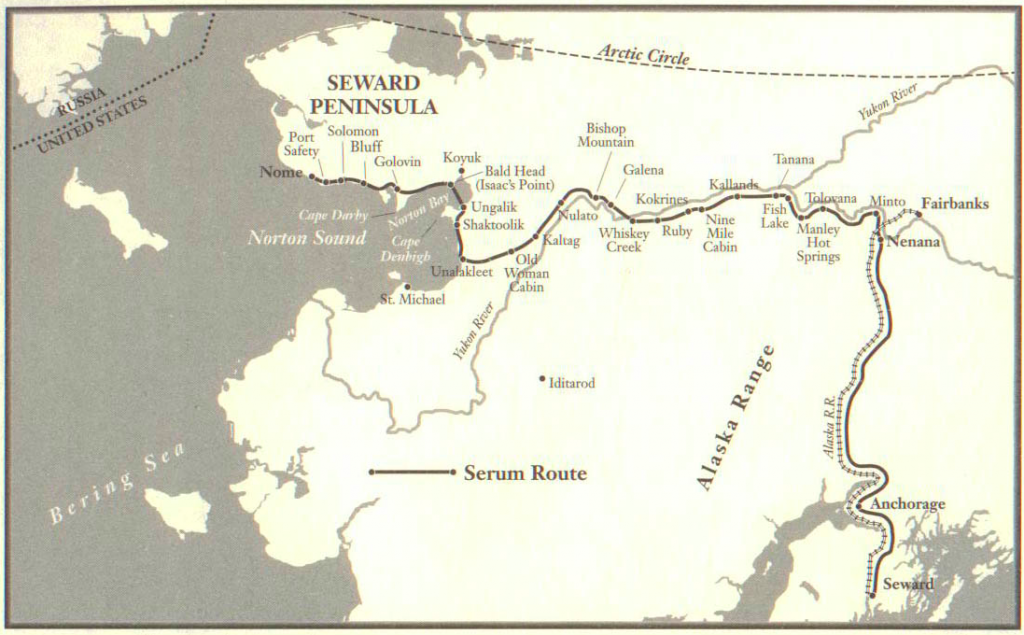Alaska’s Super Hero Dogs

Nome, Alaska, is one of the northernmost and westernmost cities in the United States. You can see it at the southwestern edge of the Seward Peninsula on the map above, but all you need to know is that it’s very remote and hard to get to. Turn back the clock to the 1890s and it was even harder to get to Nome — there was obviously no airport, as planes hadn’t been invented yet, but there was also no seaport. Despite the fact that Nome sits on the North Sound of the Bering Sea, non-natives didn’t really have a reason to go there, so the infrastructure needed to get to Nome wasn’t yet built.
That changed in 1898. Gold was discovered on Nome’s beaches, sparking a massive influx of new people to the area. By 1900, Nome’s population spiked to more than 12,000 people, making it Alaska’s most populous city at the time. The population fell precipitously shortly thereafter, though; the harsh winters were enough to convince more than 80% of the population to leave before the decade was out. By 1924, Nome was home to only about 1,200 people, about a third of which were indigenous. The greater Nome region had, maybe, 10,000 total residents.
But when winter came to Nome in 1924, it didn’t come alone. Diphtheria, an infection caused by a certain strain of bacteria, struck the region. While the now-common diphtheria vaccine had been created a year prior, it hadn’t been produced widely yet and certainly hadn’t reached Nome. There was, thankfully, a treatment available — an injectable antitoxin which, when given to an infected patient, typically would cure them before it was too late. However, if left untreated, diphtheria was often fatal. And to make matters worse, it is very infectious, able to spread rapidly throughout a community.
And Nome was about to be in trouble. Dr. Curtis Welch, Nome’s only physician, believed the hospital had a large enough supply of antitoxin on hand. But he was wrong: it had expired. And by the time he noticed, it appeared to be too late to get more. Nome’s port, which had been built in response to the gold rush, was blocked off by ice, and was not likely to be navigable until the spring. The University of Alaska, Anchorage summarized the dire situation:
Desperate, Welch sent a radio telegram to all the major Alaska towns, to territorial Governor Scott Bone in Juneau, and to the U.S. Public Health Service in Washington D.C. He wrote to the Health Service:
An epidemic of diphtheria is almost inevitable here. Stop. I am in urgent need of one million units of diphtheria antitoxin, stop, mail is only form of transportation. Stop. I have made application to Commissioner of Health of the Territories for antitoxin already. Stop. There are about 3000 (sic) white natives in the district.
By the end of January, Welch had 20 more confirmed cases and 50 more at risk. He knew the inevitable: without the antitoxin, the disease would kill the area’s entire population of about 10,000 people.
The good news: there was plenty of antitoxin available in Seward, Alaska, and a railway could get the antitoxin to the Alaskan town of Nenana, as seen in the map above. That was still another 674 miles from Nome, with no roads nor rails to transverse that distance. The cold conditions were too much for an airplane to handle. The only option left: teams of sled dogs.
According to the American Kennel Club, within days, “a relay of 20 teams was assembled, including that of Leonhard Seppala, Alaska’s most venerated musher.” Their task was to beat the clock. As the BBC explained, “[in normal conditions], the entire route would ordinarily take the postal service 25 days, but that was far too long. In the brutal weather conditions, the serum would only last six. The dogs would have to complete the journey in less than a quarter of the normal time.” And on January 27, 1925, the first sled dog team left Nenana, antitoxin in hand, and braving temperatures as low as −50 °F (−46 °C).
Miraculously, it worked. Five and a half days later, the sled dog relay’s final leg entered Nome, saving thousands of lives.
Today, two of the dogs are honored with statues in New York City: Balto, who led the team in that final drive; and Togo, who with Seppala, “traversed an astounding 264 miles, compared to an average of 31 miles each for the other teams” according to the American Kennel Club.
Bonus fact: It’s unclear where Nome, Alaska, got its name, but one of the likely explanations is that it was a mistake. According to the Nome Convention and Visitors Bureau, “in the 1850s, an officer on a British ship off the coast of Alaska noted on a manuscript map that a nearby prominent point was not identified. He wrote ‘? Name’ next to the point. When the map was recopied, another draftsman thought that the ? was a C and that the a in “Name” was an o, and thus a map-maker in the British Admiralty christened ‘Cape Nome.'”
From the Archives: Endal: Another heroic dog.
